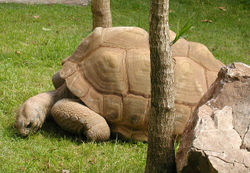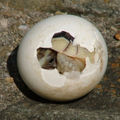| Tortoises | ||||||||||||||
|---|---|---|---|---|---|---|---|---|---|---|---|---|---|---|

Aldabra Giant Tortoise
(Geochelone gigantea) from Aldabra atoll in the Seychelles. |
||||||||||||||
| Scientific classification | ||||||||||||||
|
||||||||||||||
|
Chersina Dipsochelys Furculachelys Geochelone Gopherus Homopus Indotestudo Kinixys Malacochersus Manouria Psammobates Pyxis Testudo |
A tortoise is a land-dwelling reptile of the order Testudines.
Contents |
Description
Like its aquatic cousins, the turtle and the terrapin, the tortoise is shielded from predators by a shell. The top part of the shell is the carapace, the underside is the plastron, and the two are connected by the bridge. The tortoise has both an endoskeleton and an exoskeleton. Tortoises can vary in size from a few centimetres to two meters. Most land tortoises are herbivorous in the wild. The carapace can help indicate the age of the tortoise by the number of concentric rings, much like the cross-section of a tree. Males tend to have a longer, protruding neck plate than their female counterparts.
Tortoises tend to be diurnal animals with tendencies to be crepuscular depending on the ambient temperatures. They are generally reclusive and shy.
Most land based tortoises are herbivores, feeding on grazing grasses, weeds, leafy greens, flowers, and certain fruits. Their main diet consists of alfalfa, clover, dandelions, and leafy weeds.
Female tortoises dig and lay about a dozen eggs in burrows or holes they dig. Hatchlings take approximately 90-120 days to incubate from ping-pong-ball sized eggs. The hatchlings break out of their shells with a front beak. Most hatchlings are born with an embryonic egg sac, serving as a source of food for the first couple of days. They are capable of eating solid food in about 3-7 days.
The giant tortoises of the Galápagos Islands helped Charles Darwin formulate his theory of evolution, since the isolated populations on the different islands, although descended from a common ancestor, had diverged to different forms.
The first turtles already existed in the era of the dinosaurs, some 300 million years ago. Turtles and tortoises are the only surviving branch of the even more ancient clade Anapsida, which includes groups such as the procolophonoids, millerettids and pareiasaurs. Most of the anapsids became extinct in the late Permian period, with the exception of the procolophonoids and the precursors of the testudines (turtles and tortoises).
While the Oxford English Dictionary refers to a tortoise as a "slow-moving land reptile with a scaly or leathery domed shell into which it can retract its head and legs" [1], in American English it is not uncommon for such animals to be referred to as turtle.
Lifespan
Tortoises generally have lifespans comparable with those of human beings, and some individuals are known to have lived longer than 150 years. Because of this, they symbolize longevity in some cultures, such as China. The oldest tortoise ever recorded, indeed the oldest individual animal ever recorded, was Tui Malila, who was presented to the Tongan royal family by the British explorer Captain Cook shortly after its birth in 1777. Tui Malila remained in the care of the Tongan royal family until its death by natural causes on May 19, 1965. This means that upon its death, Tui Malila was 188 years old [2], a figure that gives it the title of oldest Cheloniinae (tortoise or turtle) ever recorded.
The Alipore zoo in India was the home to Adwaitya, which zoo officials claimed was the oldest living creature until its death on Thursday, March 23, 2006. Adwaitya (sometimes spelled with two d's) was an Aldabra Giant Tortoise brought to India by Lord Wellesley who handed it over to the Alipur Zoological Gardens in 1875 when the zoo was set up. Zoo officials state they have documentation showing that Adwaitya was at least 130 years old, but claim that he was over 250 years old (although this has not been scientifically verified). Adwaitya was said to be the pet of Robert Clive 1.
Harriet, a resident at the Australia Zoo in Queensland, was apocryphally thought to have been brought to England by Charles Darwin aboard the Beagle. Harriet died on June 23, 2006, just shy of her 176th birthday.
Partial species list
-
Chersina
- Chersina angulata, Bowsprit Tortoise
-
Dipsochelys
- Dipsochelys abrupta, Conservation status: Extinct
Dipsochelys arnoldi, Arnold's Giant Tortoise, Conservation status: Extinct in the wild
Dipsochelys daudinii, Conservation status: Extinct
Dipsochelys dussumieri, Aldabra Giant Tortoise, Conservation status: Vulnerable
Dipsochelys grandidieri, Conservation status: Extinct
Dipsochelys hololissa, Seychelles giant tortoise, Conservation status: Extinct in the wild
- Dipsochelys abrupta, Conservation status: Extinct
-
Furculachelys
- Furculachelys nabeulensis, Tunisian Spur-thigh Tortoise
-
Geochelone
- Geochelone carbonaria, Red-Footed Tortoise
Geochelone chilensis, Chaco Tortoise, Conservation status: Vulnerable
Geochelone denticulata, Yellow-Footed Tortoise, Conservation status: Vulnerable
Geochelone elegans, Indian Star Tortoise
Geochelone nigra, Galápagos Giant Tortoise, Conservation status: Vulnerable
Geochelone pardalis, Leopard Tortoise
Geochelone platynota, Burmese Star Tortoise, Conservation status: Critical
Geochelone radiata, Radiated Tortoise, Conservation status: Vulnerable
Geochelone sulcata, African Spurred Tortoise (Sulcata Tortoise)
Geochelone yniphora, Angulated Tortoise, Conservation status: Endangered
- Geochelone carbonaria, Red-Footed Tortoise
-
Gopherus
- Gopherus agassizii, Desert Tortoise,
Conservation status: Vulnerable
Gopherus berlandieri, Texas Tortoise
Gopherus flavomarginatus, Bolson Tortoise, Conservation status: Vulnerable
Gopherus polyphemus, Gopher Tortoise, Conservation status: Vulnerable
- Gopherus agassizii, Desert Tortoise,
Conservation status: Vulnerable
-
Homopus
- Homopus aerolatus, Parrot-Beaked Cape Tortoise
Homopus boulengeri, Boulenger's Cape Tortoise
Homopus femoralis, Karroo Cape Tortoise
Homopus signatus, Speckled Cape Tortoise, Conservation status: Lower risk
Homopus bergeri, Berger's Cape Tortoise, Conservation status: Vulnerable
- Homopus aerolatus, Parrot-Beaked Cape Tortoise
-
Indotestudo
- Indotestudo elongata, Elongated Tortoise,
Conservation status: Endangered
Indotestudo forsteni, Travancore Tortoise, Conservation status: Endangered
- Indotestudo elongata, Elongated Tortoise,
Conservation status: Endangered
-
Kinixys
- Kinixys belliana, Bell's Hinge-Backed Tortoise
Kinixys erosa, Serrated Hinge-Backed Tortoise, Conservation status: Data deficient
Kinixys homeana, Home's Hinge-Backed Tortoise, Conservation status: Data deficient
Kinixys natalensis, Natal Hinge-Backed Tortoise, Conservation status: Lower risk
Kinixys spekii
- Kinixys belliana, Bell's Hinge-Backed Tortoise
-
Malacochersus
- Malacochersus tornieri, Pancake Tortoise, Conservation status: Vulnerable
-
Manouria
- Manouria emys, Brown Tortoise (Mountain
Tortoise), Conservation status: Endangered
Manouria impressa, Impressed Tortoise, Conservation status: Vulnerable
- Manouria emys, Brown Tortoise (Mountain
Tortoise), Conservation status: Endangered
-
Psammobates
- Psammobates geometricus, Geometric Tortoise,
Conservation status: Endangered
Psammobates oculiferus, Serrated Star Tortoise
Psammobates tentorius, African Tent Tortoise
- Psammobates geometricus, Geometric Tortoise,
Conservation status: Endangered
-
Pyxis
- Pyxis arachnoides, Madagascan Spider Tortoise,
Conservation status: Vulnerable
Pyxis planicauda, Madagascan Flat-Tailed Tortoise, Conservation status: Endangered
- Pyxis arachnoides, Madagascan Spider Tortoise,
Conservation status: Vulnerable
-
Testudo
- Testudo graeca, Greek Tortoise (Spur-Thighed
Tortoise), Conservation status: Vulnerable
Testudo hermanni, Herman's Tortoise, Conservation status: Lower risk
Testudo horsfieldii, Russian Tortoise (Horsfield's Tortoise, or Central Asian Tortoise)
Testudo kleinmanni, Egyptian Tortoise, Conservation status: Critical
Testudo werneri, Negev Tortoise, Conservation status: Critical
Testudo marginata, Marginated Tortoise
Testudo tabulata, Jabuti
- Testudo graeca, Greek Tortoise (Spur-Thighed
Tortoise), Conservation status: Vulnerable
Further reading
- Chambers, Paul. A Sheltered Life: The Unexpected History of the Giant Tortoise. John Murray (Publishers), London. 2004. ISBN 0-7195-6528-6.
- Gerlach, Justin. Giant Tortoises of the Indian Ocean. Chimiara publishers, Frankfurt. 2004
See also
External links
Gallery

A baby
Testudo marginata emerges from its
shell
|

Testudo marginata
|

Testudo graeca ibera,Testudo
hermanni boettgeri,Testudo hermanni
hermanni,Testudo marginata sarda
|

Testudo hermanni boettgeri
|

A young (3.5 years) Sulcata Tortoise
Geochelone sulcata
|

Aldabra Giant Tortoise Geochelone
gigantea from Aldabra atoll in the
Seychelles
|

Testudo graeca ibera
|

Aldabra Giant Tortoise Geochelone
gigantea
|